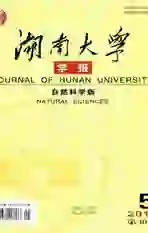酸改性活性炭吸附甲苯的性能研究
2013-04-29李立清石瑞顾庆伟梁鑫唐琳李海龙马卫武
李立清 石瑞 顾庆伟 梁鑫 唐琳 李海龙 马卫武
摘要:商业活性炭分别经过1 mol/L的硝酸、盐酸、硫酸处理.采用Boehm滴定、傅式转换红外光谱仪(FTIR)、比表面积分析仪对活性炭样品的物化性质进行测试.以甲苯为吸附质,在283 K下进行了固定床吸附实验.研究讨论了改性前后活性炭对甲苯的吸附量影响,计算了相应的动力学参数和吸附能.结果表明:酸改性可以增加活性炭表面酸性官能团的总数量;改变孔径分布.酸改性活性炭对甲苯的吸附量大小顺序为:NAC,SAC,AC,ClAC.准二阶动力学方程比准一阶动力学能更好地描述甲苯在改性活性炭上的吸附过程;酸改性增大了微孔占有率,提高了吸附速度;酸改性增大活性炭吸附有机气体的吸附能,导致酸改性活性炭与甲苯结合度降低.
关键词:改性活性炭;表面基团;孔结构;吸附动力学;吸附能
中图分类号:O613.71 文献标识码:A
2.5.3酸改性活性炭孔结构参数对吸附性能影响
酸改性改变了活性炭的比表面积、总孔容.图6给出了酸改性活性炭性能参数与吸附量之间的关系.
由图6可知,活性炭的比表面积、总孔容与吸附量并未呈良好的线性关系,但酸改性活性炭对甲苯的吸附量,随着活性炭的比表面积、总孔容的增大而增大.这是由于活性炭的比表面积是由微孔比表面积、中孔比表面积、大孔比表面积共同构成的.甲苯属于大分子吸附质,甲苯的有效吸附比表面积为微孔比表面积和中孔比表面积,占总比表面积比例较大.同理,酸改性活性炭吸附甲苯的有效孔容积也由微孔容积和部分中孔容积共同贡献.
3结论
1)用酸对活性炭进行改性,可以提高活性炭表面的酸性官能团数量,且酸性官能团数量随着改性酸试剂氧化性的增强而增多.酸对活性炭孔结构具有侵蚀、氧化作用.硝酸的强氧化性导致活性炭孔容增大;硫酸、盐酸的强酸性导致活性炭孔结构受到侵蚀,孔容变小.酸改性导致活性炭灰分被脱出,疏通了孔道结构.
2)酸改性活性炭对甲苯的吸附量大小顺序为:NAC,SAC,AC,ClAC,吸附量受到孔结构和表面官能团的共同作用.
3)酸改性活性炭的吸附量随着有效比表面积、有效孔容的增大而增大.
4)准一阶、准二阶动力学方程都可以描述甲苯在改性活性炭上的吸附过程,但实验数据对准二阶动力学方程拟合系数相对较高,表明酸性官能团在活性炭吸附甲苯过程中作用显著.酸改性增大了微孔占有率,提高了吸附速度.
5)酸改性增大活性炭吸附有机气体的吸附能,导致酸改性活性炭与甲苯结合度降低.
参考文献
[1]WANG Ding,ELISABETH MCLAUGHLIN,ROBERT PFEFFER,et al. Aqueous phase adsorption of toluene in a packed and fluidized bed of hydrophobic aerogels[J].Chemical Engineering Journal,2011,168(3):1201-1208.
[2]JENSEN L K, LARSEN A, MLHAVE L, et al.Volatile organic compounds from wood and their influences on museum artifact materials I. Differences in wood species and analyses of causal substances of deterioration[J].Archives of Environmental Health, 2001, 56(5): 419-432
[3]GHEZINI R, SASSI M, BENGUEDDACH A. Adsorption of carbon dioxide at high pressure over HZSM5 type zeolite. Micropore volume determination by using the Dubinin Raduskevich equation and “tplot” method[J], Microporous and Mesoporous Materials, 2008, 113(1-3): 370-377
[4]KIM B J, PARK S J. Influence of surface treatments on micropore structure and hydrogen adsorption behavior of nanoporous carbons[J].Journal of Colloid and Interface Science, 2007, 311(2): 619-621
[5]LILLORDENAS M A, CAZORLAAMORS D, LINARESSOLANO A. Behaviour of activated carbons with different pore size distributions and surface oxygen groups for benzene and toluene adsorption at low concentrations[J].Carbon, 2005, 43(8): 1758-1767
[6]HAYDAR S,FERROGAREA M,RIVERAUTRILLA J,et a1.Adsorbtion of pnitrophcnol on all activated carbon winl different oxidations[J].Mieroporous Materials,2003,4l(3):387-395.
[7]李开喜,吕春祥,凌立成.活性炭纤维的脱硫性能[J].燃料化学学报,2002,30(1):89-95.
LI Kaixi, LV Chunxiang, LING Licheng, Activated carbon fiber for desulfuration performance[J]. Journal of Fuel Chemistry and Technology,2002,30(1):89-95.(In Chinese)
[8]KIM D J, LEE H I. Ordered mesoporous carbons: Implication of surface chemistry, pore structure and adsorption of methyl mercaptan[J]. Carbon,2005,43(9):1868-1873.
[9]单晓梅、朱书全.氧化法改性煤基活性炭和椰壳活性炭的研究[J].中国矿业大学学报,2003,32(6),729-733.
SHAN Xiaomei, ZHU Shuquan. Oxidation modification based coal activated carbon and coconut shell activated carbon[J]. Journal of China University of Mining and Technology,2003,32(6): 729-733.(In Chinese)
[10]CHEN J P, WU S. Acid/basetreated Toluene adsorption at low on centration [J]. Langmuir, 2004, 20(6):2233-2242.
[11]ZIELKE U, HUTTINGER K, et al. Surfaceoxidized carbon fibers: I. Surface structure and chemistry [J].Carbon, 1996, 34(16):983-998.
[12]LEON C, LEON Y. Evidence for the protonation of basal plane sites on carbon [J]. Carbon,1992, 30(5):797-811.
[13]HUANG Chenchia, LI Hongsong. Effect of surface acidic oxides of activated carbon on adsorption of ammonia [J]. Journal of Hazardous Materials, 2008, 159(2/3):523-527.
[14]QIAO Zhijun, LI Jiajun. Influence on pore structure and surface groups of activated carbon fiber over high temperature heat treatment [J]. New Carbon Materiala, 2004, 19(1): 53-56.
[15]HAMEED B H, AHMAD A A, AZIZ N. Isotherms, kinetics and thermodynamics of acid dye adsorption on activated palm ash [J]. Chemical Engineering Journal, 2007, 133(1/3):195-203.
[16]WEBER W J, MORRIS J C. Kinetics of adsorption on carbon from solution [C]//Proceedings of the International Conference on Water Pollution Symposium. London: Pergamon Oxford, 1962: 231-266.
[17]LI Liqing, LI Zheng, QIN Yingxing,et al. Estimation of volatile organic compound mass transfer coefficient in the vacuum desorption of acetone from activated carbon[J]. Journal of Chemical and Engineering Data, 2010,55(11):4732-4740.
